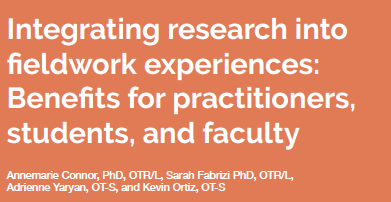Integrating research into fieldwork experiences: Benefits for practitioners, students, and faculty
 Integrating research into fieldwork experiences: Benefits for practitioners, students, and faculty
Integrating research into fieldwork experiences: Benefits for practitioners, students, and faculty
by: Annemarie Connor, PhD, OTR/L, Sarah Fabrizi PhD, OTR/L, and Adrienne Yaryan, OT-S, and Kevin Ortiz, OT-S
As new occupational therapy programs continue to develop, it has become more difficult to find fieldwork (FW) sites for students since practitioners are less willing to supervise students due to the lack of resources, limited time, and questions of student preparedness (Varland et al., 2017). Unfortunately, this predicament is now exacerbated in the era of COVID-19. Emerging practice fieldwork sites, largely focused on prevention and health promotion in community-based practice, have been one mechanism for creating meaningful and productive fieldwork sites during this increasingly challenging landscape (Clarke et al., 2015; Dancza et al., 2013).
Despite the additional time demands imposed on fieldwork educators, occupational therapy practitioners benefit from supervising FW students, as the students bring an increased knowledge of evidence-based practice and serve as connection to research opportunities. The students then benefit by applying theoretical constructs and evidence-based practice methods, as well as techniques learned in the classroom, to meet the complex needs of the diverse client base of each practice setting. A scoping review of student, FW educator, and new practitioner perspectives reveals that students’ feelings of competence are related to confidence in clinical decision making and a lack of concrete interventions strategies may act as a barrier (Patterson & D’Amico, 2020). The manualization of a complex occupational therapy intervention provides a structure for intervention delivery, facilitates training and consistency, and allows for replication in a variety of contexts (Blanche et al., 2011). Previous research has found that trained and supervised students can effectively deliver previously-validated intervention programs (Connor et al., 2021).
Occupational therapy students in non-traditional FW settings can also develop additional skills and attributes found to be beneficial in the transition to practice and support a positive trajectory for career development (Thew et al., 2018). Students offer innovative service development and delivery by having a perspective of occupation-focused practice and confidence in both themselves and the profession (Thew et al., 2018). However, students may approach non-traditional sites with some healthy skepticism. The use of manualized interventions in emerging practice FW may be one mechanism for augmenting the acceptability, feasibility, and practicality of non-traditional placements. Manualized interventions can aid FW supervisors, students, and faculty by providing structure to interventions among sites that may not have an occupational therapist on site. By implementing manualized intervention research , students develop the confidence and skills to not only implement intervention programs, but engage in program evaluation and development (Connor & Fabrizi, 2021).
The following example highlights the use of a manualized and empirically-validated intervention program as a Level I FW experience that focuses on a research directed study in a non-traditional, university setting. The Assistive Soft Skills & Employment Training (ASSET) program is a 13 session, work-related social skills group intervention designed to improve social functioning, self-efficacy, and psychological wellness among transition-age youth with demonstrated social dysfunction (Connor et al., 2020; Sung et al., 2019). Students found facilitating ASSET to be acceptable in terms of developing research and practice skills, managing time, and balancing the responsibilities of classwork while completing fieldwork and research, as measured by an 11-item, 5-point Likert-type scale known as the Facilitator Feedback Form. Overall, the students were affirmative of integrating research into fieldwork and agreed (M =4.04, SD =0.62) that they were satisfied with their experience facilitating each group session. Preliminary results of this mixed methods study suggest high levels of agreement among students regarding the feasibility of incorporating research activities into Level I psychosocial FW. In addition, it was expressed that the experience provided a safe learning environment that allowed students to enhance their group facilitation and research skills. To measure ASSET participant perspectives, a user rating profile measuring participant satisfaction and experience was used (Connor & Fabrizi, 2021). Results indicated high positivity (M = 4.47, SD = 0.38, range = 3.76-5.00) with the student-facilitated ASSET intervention. In regard to preliminary efficacy, on average, participants made statistically significant (p < .03 or less) and medium to large improvements across social functioning (d = 0.55), self-efficacy (d = 0.79), and adaptive behavior (d = 0.54; Connor et al., in press).
- In conclusion, integrating research into fieldwork experiences has benefits for students, faculty, and practitioners. Key takeaways from this work include:
- Working with a research-derived, manualized intervention allows for greater student independence and helps scaffold development of clinical skills.
- Students should consider getting involved with faculty research while enrolled in an OT program, as it increases confidence in research skills, develops clinical reasoning skills, and fosters faculty-student mentorship.
- Faculty should consider incorporating program evaluation skill building into curricula, in addition to existing ACOTE standards related to teaching students how to conduct and utilize a needs assessment.
Recognizing that students complete a research course, directed study, and implementation, as well as needs assessments in the OT curriculum, FW students can expand clinical sites’ capacity to engage in clinically-relevant research, including program evaluation and needs assessment as it relates to program development/revision. These research-related activities can successfully be integrated into FW projects that result in meaningful data for the site and creation of high-impact learning activities for students.
References
Blanche, E. I., Fogelberg, D., Diaz, J., Carlson, M., & Clark, F. (2011). Manualization of occupational therapy interventions: Illustrations from the pressure ulcer prevention research program. The American Journal of Occupational Therapy, 65(6), 711-719. doi: 10.5014/ajot.2011.001172
Connor, A., Fabrizi, S., Nasamran, A., & Sung, C. (2021). OT students as near-peer facilitation of a soft skills program for young adults with autism. American Journal of Occupational Therapy, 75(Supplement_2), 7512515349p1. https://doi.org/10.5014/ajot.2021.75S2-RP349
Connor, A., & Fabrizi, S. (2021). You evaluate your clients, do you evaluate your program? FOCUS - Spring 21, 15-16. https://fota.memberclicks.net/assets/Newsletter/2021/2021%20Spring%20FQ2Up.pdf
Connor, A., & Fabrizi, S. (2020). Manualization of occupational therapy interventions: A crucial but overlooked step in building evidence. FOCUS - Summer 20, 15-16. https://fota.memberclicks.net/assets/Newsletter/2020/2020%20FOCUS%20Summer%20fnl.pdf
Connor, A., Sung, C., Strain, A. Zeng, S., & Fabrizi, S. (2020). Building skills, confidence, and wellness: Psychosocial effects of soft skills training for young adults with autism. Journal of Autism and Developmental Disorders, 50(6), 2064–2076. doi: 10.1007/s10803-019-03962-w
Clarke, C., Martin, M., de Visser, R., & Sadlo, G. (2015). Sustaining professional identity in practice following role-emerging placements: Opportunities and challenges for occupational therapists. British Journal of Occupational Therapy, 78(1), 42–50. https://doi.org/10.1177/0308022614561238
Dancza, K., Warren, A., Copley, J., Rodger, S., Moran, M., McKay, E., & Taylor, A. (2013). Learning experiences on role-emerging placements: An exploration from the students’ perspective. Australian Occupational Therapy Journal, 60(6), 427-435. https://doi.org/10.1111/1440-1630.12079
Patterson, B., & D’Amico, M. (2020). What does the evidence say about student, fieldwork educator, and new occupational therapy practitioner perceptions of successful level II fieldwork and transition to practice? A scoping review. Journal of Occupational Therapy Education, 4(2). https://doi.org/10.26681/ jote.2020.040210
Sung, C., Connor, A., Chen, J., Lin, C., Kuo, H.J., & Chun, J. (2019). Development, feasibility and preliminary efficacy of an employment-related social skills intervention for young adults with high functioning autism. Autism, 23(6):1542-1553. doi: 10.1177/1362361318801345
Thew, M., Thomas, Y., & Briggs, M. (2018). The impact of a role emerging placement while a student occupational therapist, on subsequent qualified employability, practice and career path. Australian Occupational Therapy Journal, 65(3), 198-20. https://doi.org/10.1111/1440-1630.12463
Varland, J., Cardell, E., Koski, J., & McFadden, M. (2017). Factors influencing occupational therapists’ decision to supervise fieldwork students. Occupational Therapy In Health Care, 31(3), 238-254. https://doi.org/10.1080/07380577.2017.1328631
